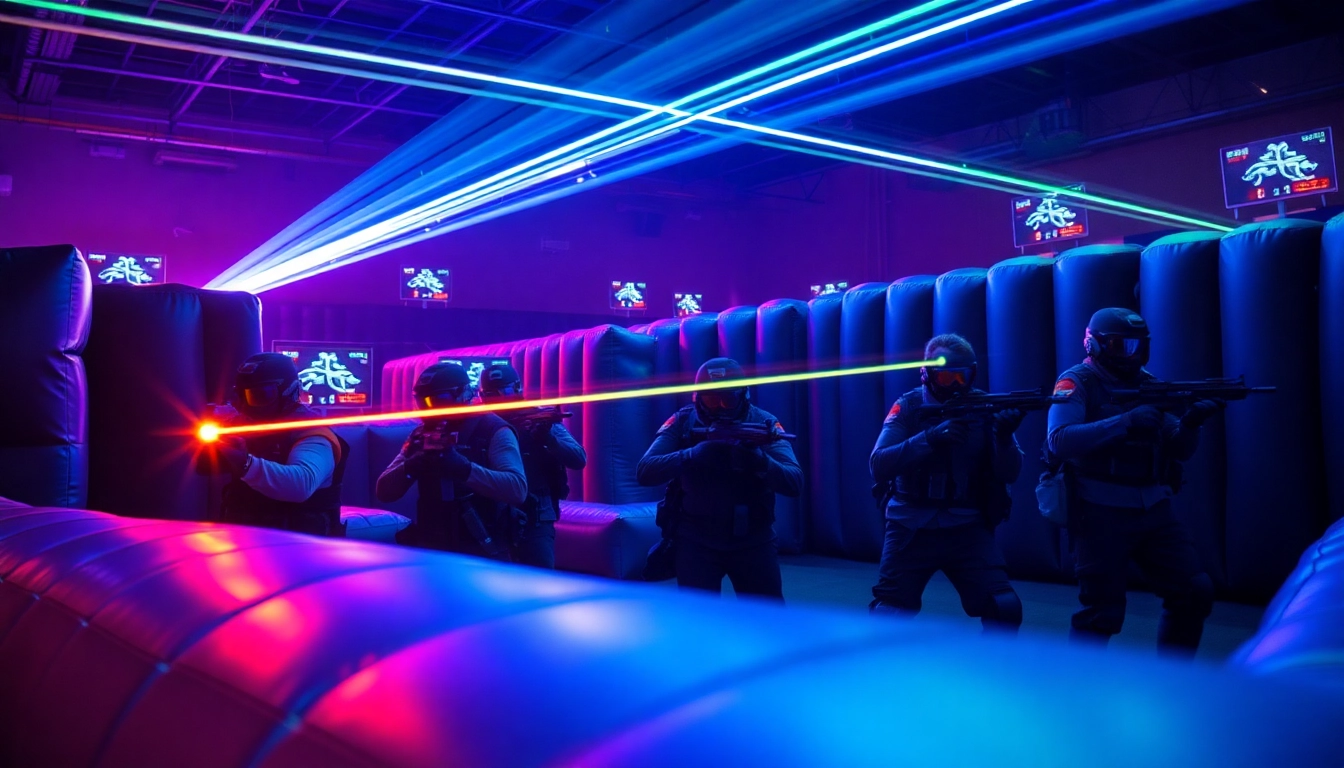1. What is Laser Tag?
1.1 Overview of Laser Tag Gameplay
Laser tag is an exhilarating, team-based game where players engage in simulated combat using laser-emitting guns. The objective is often to tag opponents while avoiding being tagged themselves. Typically, the diverse gameplay features tactical elements, obstacle-laden arenas, and the use of teamwork to achieve success. As participants traverse various terrains, they use strategy, speed, and stealth to outmaneuver their opponents while accomplishing specific mission objectives.
The game consists of multiple rounds, usually lasting between 5 to 15 minutes depending on the venue and arrangement. Teams accumulate points by tagging opponents and fulfilling challenges, such as capturing bases or completing scavenger hunts within the play area. As players engage in this fast-paced action, they not only enjoy the thrill of competition but also foster camaraderie and collaboration.
1.2 Equipment Used in Laser Tag
Laser tag venues utilize various equipment designed to enhance the gaming experience. The primary weapon is the infrared-emitting laser gun, equipped with sensors to detect hits. These guns come in different styles, often resembling military-grade weapons or futuristic designs suited for sci-fi themes. Each gun incorporates advanced technology, including sound effects, LED lights, and even scoring systems that provide immediate feedback on hits and misses.
In addition to guns, players wear vests or harnesses fitted with sensors placed strategically to detect incoming “tags.” Some arenas incorporate additional equipment like headbands that enhance safety and ensure all players can play comfortably. The quality and sophistication of this equipment can vary significantly between venues, influencing the overall gaming experience.
1.3 The Evolution of Laser Tag
The origins of laser tag can be traced back to the late 1970s and early 1980s, stemming from early arcade games and entertainment. Initially, players engaged in live-action role-play scenarios utilizing similar technology found in military training simulations. Early versions of the game implemented rudimentary tags, resulting in a base level of engagement for patrons.
As technology advanced, so did laser tag. The introduction of infrared technology allowed for more accuracy and realism in gameplay, catering to a broader audience. Over the decades, various entertainment venues embraced laser tag as a staple attraction within family entertainment centers, amusement parks, and dedicated laser tag arenas. Today’s laser tag experience merges high-tech equipment with immersive arena designs and thematic contexts, providing high-energy fun for individuals of all ages.
2. Benefits of Playing Laser Tag
2.1 Promoting Physical Activity
One of the most significant advantages of laser tag is that it promotes physical activity in a fun and engaging way. Unlike traditional exercise routines that may feel repetitive or uninspiring, laser tag provides a thrilling environment that encourages players to run, hide, and maneuver quickly. Awakened by adrenaline, participants can expect cardiovascular workouts while enjoying a sense of competition.
Reports indicate that playing laser tag can burn hundreds of calories in a single session, making it an effective choice for those looking to increase their physical fitness while having fun with friends or family. This unique form of exercise is suitable for players of varied fitness levels, ensuring that everyone can participate and benefit.
2.2 Enhancing Teamwork Skills
Laser tag is inherently a team-oriented activity requiring players to collaborate and strategize together. Team success hinges on effective communication, collaboration, and rapid decision-making skills. As participants engage in team-based missions, they learn to assess situations quickly and adjust tactics based on the movement and behavior of opponents.
The experience fosters social engagement and enhances interpersonal skills as players navigate challenges together, forming bonds that extend beyond the game. Developing teamwork skills in a fun environment helps players enhance their organizational prowess in real-world situations like schools, workplaces, and other team-intensive settings.
2.3 Stress Relief Through Adventure
For many, laser tag serves as a delightful distraction from daily stresses and obligations. Engaging in thrilling adventures and immersive scenarios allows players to unwind and escape from the pressures of everyday life. The dynamic nature of play, combined with the exhilarating role-playing elements, provides an emotional release that can greatly help in relieving stress.
Furthermore, during laser tag matches, players enter a flow state where they fully concentrate on the game rather than external worries. This zen-like experience can significantly enhance overall well-being and mental health, thus providing dual benefits through physical activity and emotional engagement.
3. How to Choose a Laser Tag Venue
3.1 Factors to Consider When Selecting a Location
When looking for a laser tag venue, several critical factors warrant consideration. The first element is the quality of equipment and technology used at the facility. Venues that invest in the latest gear often provide a superior experience, maximizing fun while reducing the likelihood of equipment failure during gameplay.
Next, consider the layout and design of the arena. A well-designed arena will feature diverse environments, such as obstacles, hiding spots, and thematic details that create an immersive experience. Player safety and the venue’s operational protocols are also paramount. Look for venues with proper guidelines in place regarding gameplay rules, safety equipment, and staff presence throughout the gaming sessions.
3.2 Comparing Indoor vs. Outdoor Laser Tag
Choosing between indoor and outdoor laser tag plays a pivotal role in shaping the overall experience. Indoor laser tag typically features compact arenas with intricate designs, control over lighting and sound effects, and constant climate conditions. These venues often have elaborate themes, immersing players in entirely different worlds, regardless of the weather outside.
Outdoor laser tag, contrastingly, offers vast landscapes and the thrill of natural elements. Such environments may foster varied gameplay strategies and allow for larger groups. Players can enjoy the unpredictability of the outdoor elements, leading to unique challenges in every match. Whether players gravitate towards the immersive excitement of indoor arenas or the expansive freedom of outdoor fields, understanding the difference can significantly enhance their experience.
3.3 Popular Venues for Laser Tag
Numerous venues across the globe cater to laser tag enthusiasts, with several noteworthy destinations recognized for their exceptional offerings. For example, laser tag can be found in diverse settings ranging from dedicated entertainment centers like Laser Ops Tampa, which features highly immersive tactical arenas, to adventurous outdoor locations such as gaming parks that offer unique challenges with natural terrains.
Other popular venues include franchises like Urban Air and Elev8 Fun, which frequently incorporate laser tag alongside other thrilling activities such as arcade games and virtual reality experiences. Each of these arenas brings a distinct flair to laser tag experiences, establishing themselves as frontrunners in engaging players on exhilarating adventures.
4. Organizing a Laser Tag Event
4.1 Planning for Birthday Parties and Corporate Events
Planning a laser tag event, whether for a birthday party or a corporate gathering, requires deliberate consideration to ensure an enjoyable experience for all participants. Start by determining the venue that meets the criteria of your group in terms of size, location, and quality of equipment. Many venues offer complete packages, providing not only laser tag games but also options for catering, party rooms, and additional activities to keep guests entertained.
Set expectations regarding the number of participants and consider the logistics involved, including prior reservations, age groups, and skill levels. An excellent approach is to incorporate various game modes and objectives to appeal to players of all backgrounds. Communication is key; provide attendees with all the necessary details about the event, ensuring everyone knows what to expect on game day.
4.2 Budgeting and Pricing Breakdown
An essential aspect of organizing a laser tag event is budgeting properly. Costs vary widely depending on factors like venue location, the duration of play, and equipment rental fees. Estimate expenses by considering pricing for gaming sessions, food and drinks, party favors, and any additional services like professional photography or decoration. In many cases, birthday package deals may offer significant savings, where multiple elements are bundled together.
Many laser tag venues provide clear pricing structures to help with budgeting. For example, a single game may range from $7 to $12 per person, with package deals offering better rates per person for multiple games. Always communicate with the venue’s event coordinator to ensure that all potential resources are accounted for and to find the best value possible.
4.3 Tips for a Successful Laser Tag Gathering
To ensure a memorable laser tag gathering, preparation and communication are fundamental. Arrive early at the venue to ensure all participants are briefed about rules, game formats, and safety guidelines before gameplay commences. Organizing players into balanced teams based on abilities can enhance competitiveness and keep everyone engaged throughout the games. Incorporate variations in gameplay types, from team vs. team battles to objective-driven missions, to keep the experience fresh and exciting.
Also, consider implementing a small awards ceremony or recognition for standout players. Prizes or certificates can create motivation and enhance the joy of completion among players. Finally, encourage feedback from attendees post-event to gain insights for future planning and develop an ongoing relationship with the venue for subsequent events.
5. Frequently Asked Questions About Laser Tag
5.1 How Much Does Laser Tag Cost?
The pricing for laser tag can vary significantly depending on location, duration of play, and whether package deals are available. Generally, players can expect to pay between $7 to $12 for a single game lasting roughly 5-15 minutes. Many venues also offer packages, such as $12-$20 for two games or unlimited play options from around $20 to $35 per person. It’s a good practice to check the specific venue’s pricing page or contact them for promotional deals or group rates.
5.2 What Age Groups Can Play?
Laser tag can be enjoyed by a wide range of age groups, making it an attractive activity for families and friends. Generally, children aged 6 and above can participate, though some venues consider players under this age too small for the gear used. It’s a good idea to verify age restrictions with your desired venue, as certain establishments might have specific requirements to ensure the safety and enjoyment of all players involved.
5.3 Safety Concerns and Myths Surrounding Laser Tag
Despite occasional concerns surrounding the safety of laser tag, the game is regarded as a safe recreational activity. The guns used emit infrared rays that are harmless to the eyes, akin to remote controls or other household electronic devices. Most venues provide proper guidance and safety instructions to ensure that all players adhere to accepted safety measures during gameplay. Understanding these facets can alleviate concerns and encourage more people to experience the joys of laser tag.








